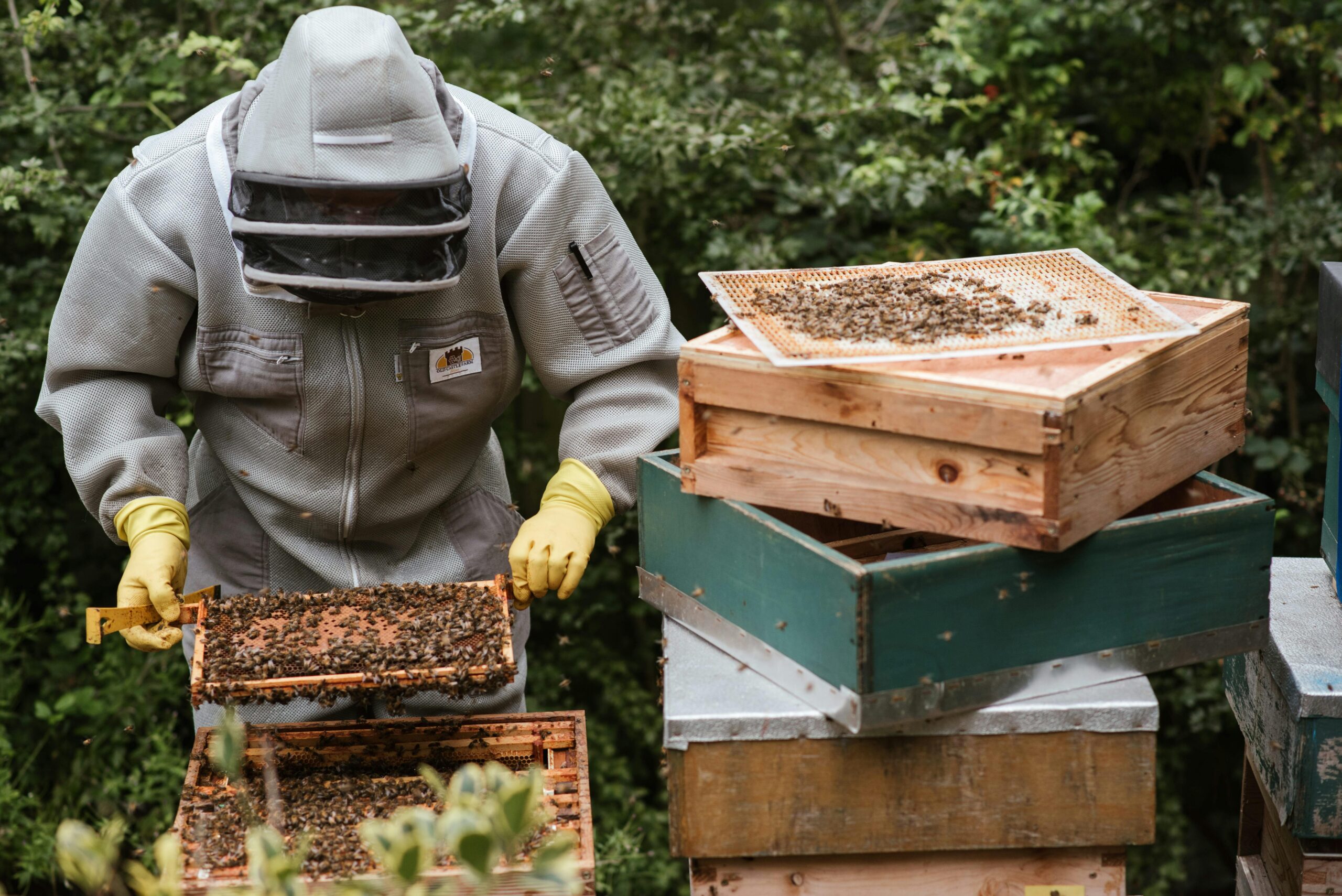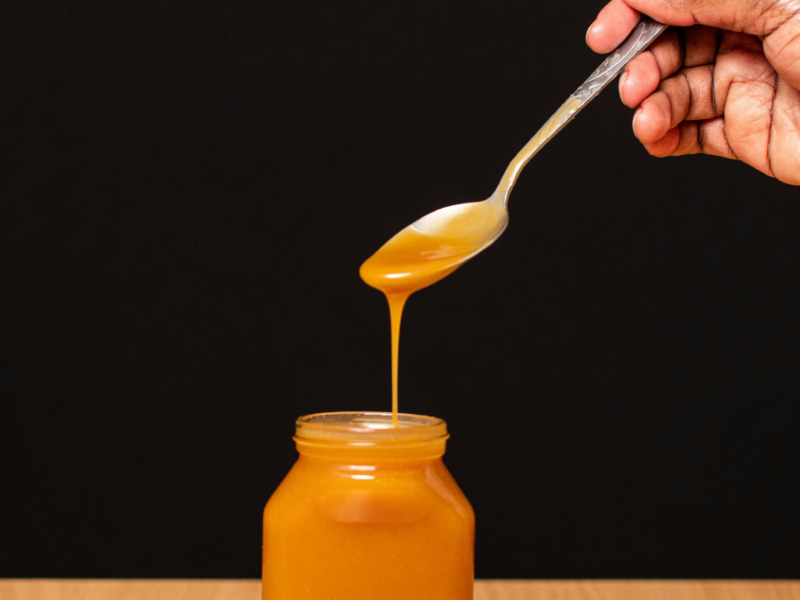1. Introduction
Honey is one of nature’s most remarkable creations — a sweet golden liquid crafted entirely by bees. But few people understand how complex and fascinating the process truly is. From the first drop of nectar collected by foraging bees to the final jar sealed by the beekeeper, raw honey represents an extraordinary collaboration between nature and human care.
This article takes you deep inside the hive, explaining exactly how honey is made, harvested, and preserved in its purest form.
2. The Journey of Nectar: From Flower to Hive
Every drop of honey begins as nectar — a sugary liquid produced by flowers to attract pollinators. Worker bees visit hundreds of blossoms each day, using their long proboscis (tongue) to sip nectar and store it in a specialized organ called the honey stomach.
During a single trip, a bee can carry about 70 mg of nectar, visiting 50–100 flowers. When the bee returns to the hive, the transformation begins.

3. How Bees Transform Nectar into Honey
Inside the hive, the forager bee passes the nectar to house bees, who begin breaking down complex sugars using enzymes like invertase. This process transforms sucrose into glucose and fructose — the main sugars in honey.
To reduce the nectar’s high water content, worker bees fan their wings to evaporate moisture. Over time, the liquid thickens into honey with about 18% water.
Once fully ripened, the bees seal the honeycomb cells with wax caps, preserving it for long-term storage — nature’s way of ensuring the colony’s survival through winter.
4. Inside the Hive: The Role of Worker Bees
Worker bees are the heart of honey production.
Their roles include:
- Foragers – collect nectar, pollen, water, and propolis
- House bees – process nectar and maintain hive temperature
- Cappers – seal finished honey with wax
- Guards – protect the hive from intruders
On average, one tablespoon of honey represents the lifetime work of about 12 bees.
5. Signs That Honey Is Ready to Harvest
Beekeepers should only harvest honey when it’s fully ripened to prevent fermentation. Key signs include:
- Capped cells: At least 80% of the honeycomb is sealed.
- Thick texture: Honey drips slowly from frames.
- Low moisture: 17–18% is ideal for storage.
Harvesting too early results in watery honey that spoils quickly.
6. Step-by-Step: How Beekeepers Extract Raw Honey
Step 1: Removing the Frames
Beekeepers use a bee brush or blower to gently clear bees from the frames before removing them from the hive.
Step 2: Uncapping the Honeycomb
The thin wax layer that seals the honey is sliced off using a heated uncapping knife or roller.
💡 Tip: Save the cappings! They can be melted down to make pure beeswax for candles and balms.
Step 3: Extracting the Honey
The frames are placed into a centrifugal honey extractor. Spinning releases the honey from the comb without damaging it.
Step 4: Filtering
The extracted honey passes through fine strainers or cheesecloth to remove wax particles and debris.
Step 5: Settling and Bottling
The filtered honey is left to rest for 24–48 hours so air bubbles rise to the surface before bottling.

8. What Makes Raw Honey Different from Processed Honey
| Feature | Raw Honey | Processed Honey |
|---|---|---|
| Heat Treatment | Unheated | Heated & pasteurized |
| Nutrient Retention | High (enzymes & pollen intact) | Reduced |
| Flavor | Natural, floral | Uniform, less complex |
| Crystallization | Normal | Slower due to filtering |
| Color Variation | Depends on nectar source | Usually light & clear |
9. Health Benefits of Raw Honey
Raw honey isn’t just delicious — it’s a natural superfood.
🩺 1. Antioxidant Power
Contains flavonoids and phenolic acids that combat oxidative stress.
💪 2. Antibacterial & Antifungal Properties
Raw honey produces small amounts of hydrogen peroxide, a natural antiseptic.
😷 3. Cough & Throat Relief
Soothes irritation and acts as a natural cough suppressant.
🌿 4. Digestive Support
Helps balance gut bacteria and relieve acid reflux.
🧴 5. Skin Health
Used in face masks and balms to treat acne, dryness, and burns.
🍯 Related Articles
10. Common Mistakes in Honey Extraction
| Mistake | Consequence |
|---|---|
| Harvesting unripe honey | Fermentation and spoilage |
| Using plastic containers | Odor absorption and contamination |
| Overheating honey | Loss of nutrients |
| Not cleaning equipment | Bacterial contamination |
| Extracting during humid weather | High moisture content |
11. Sustainable Honey Harvesting Practices
Modern beekeeping emphasizes sustainability. Responsible harvest means ensuring bees have enough honey left to survive.
Tips:
- Leave 30–40 lbs (14–18 kg) of honey for winter stores.
- Avoid excessive disturbance during the nectar flow.
- Recycle wax and propolis.
- Support local wildflowers and reduce pesticide use.
12. Did You Know?
💡 One honeybee visits about 2 million flowers to make a single pound of honey.
💡 The average hive produces 30–60 lbs of surplus honey per season.
💡 Honey has no expiration date — ancient Egyptian honey was found still edible after 3,000 years!
13. FAQ
Q1: How long does it take bees to make honey?
It depends on nectar availability — typically 2–3 weeks for a colony to fill a honey super.
Q2: What’s the difference between raw and organic honey?
Raw honey isn’t heated or filtered; organic honey comes from hives far from pesticide-treated crops.
Q3: Can I eat honey straight from the comb?
Yes! Comb honey is 100% edible and rich in natural enzymes and wax.
Q4: Why does honey crystallize?
Natural sugars (mainly glucose) solidify over time; it’s a sign of purity, not spoilage.
Q5: What’s the best way to liquefy crystallized honey?
Warm the jar gently in a bowl of hot water (not boiling) until smooth.
15. Conclusion
From the nectar gathered by foraging bees to the golden jars on our tables, honey’s journey is a testament to nature’s perfection.
Every drop represents collaboration, patience, and care — between bee and beekeeper alike.
By understanding and respecting this process, we not only produce purer honey but also strengthen the connection between humans and the natural world that sustains us.



